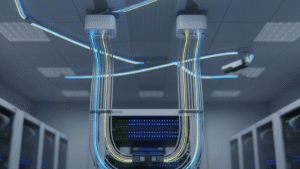Introduction: The Invisible Link Between Medical Imaging and Power
In modern medicine, imaging technologies have become the cornerstone of diagnosis. Whether it is X-ray, CT, MRI, or the increasingly applied Coronary CT Angiography (CCTA), these tools help physicians identify diseases earlier and more accurately. Yet behind these sophisticated and expensive medical devices lies an often-overlooked but indispensable component — the power adapter. Just as the heart pumps blood to sustain the body, the adapter provides stable and safe energy that determines whether the equipment can operate continuously, efficiently, and reliably.
The Importance of CCTA: Seeing the Details Inside the Heart
Coronary artery disease is one of the leading causes of death worldwide. As a non-invasive diagnostic tool, CCTA produces high-resolution images of coronary anatomy, enabling physicians to detect early plaque formation, narrowing, or blockages.
Compared to conventional coronary angiography, CCTA offers several advantages:
- Non-invasive – avoids risks associated with catheterization;
- High resolution – provides clear visualization of vascular details and stenosis;
- Rapid examination – scans can be completed within minutes;
- Early warning – reveals potential risks before severe symptoms develop.
In other words, CCTA has become an irreplaceable tool in cardiovascular care. Precision imaging allows physicians to make faster, more accurate clinical decisions — and this relies on the stable operation of advanced imaging systems.
The Logic of Medical Imaging Systems: Why Power Matters
Every imaging system — from scanning to image reconstruction, from data acquisition to analysis — requires complex electronic components to work in harmony. High-resolution detectors, image reconstruction modules, data transmission systems, and high-speed computing platforms all depend on stable power delivery.
If the power supply fluctuates, it may result in:
- Increased image noise, reducing diagnostic accuracy;
- System resets or crashes, delaying patient examinations;
- Long-term component damage, shortening equipment lifespan.
Therefore, a medical-grade power adapter is not merely a power source — it is the foundation of image quality and patient safety.
The Unique Demands of Medical Power Adapters
Unlike consumer electronics, medical devices impose far stricter requirements on power adapters. Common standards and expectations include:
• IEC60601 Compliance
The globally recognized safety standard for medical electrical equipment, IEC60601 requires low leakage current, reinforced insulation, and electrical isolation to protect both patients and medical staff.
• Low Noise and EMI Immunity
Imaging systems are highly sensitive to interference. Power adapters must suppress electromagnetic emissions to prevent signal distortion that could affect imaging quality.
• Stability and Long Lifespan
Medical devices often run 24/7, meaning adapters must withstand continuous high-load operation without performance degradation.
• Customization and Compatibility
Different manufacturers design equipment with varied voltage, current, and connector requirements. Power solutions must be flexible and adaptable.
In short, a medical adapter’s role goes far beyond “power delivery.” It ensures imaging accuracy, device longevity, and clinical reliability.
Case Study: The Interaction Between CCTA and Stable Power
Consider this scenario: a CCTA scan is being performed on a patient with suspected heart disease. During the scan, detectors must rapidly capture thousands of images within seconds, which are then reconstructed into a detailed 3D model.
If the power fluctuates, consequences may include:
- Blurred or lost images;
- Artifacts in the reconstructed model;
- The need for repeat scans, increasing patient risk and radiation exposure.
By contrast, an IEC60601-compliant, low-EMI medical-grade power adapter ensures:
- Clear, stable imaging with fewer artifacts;
- Accurate data, minimizing misdiagnosis;
- Extended system life, reducing hospital costs.
Here, the power adapter acts as a silent guardian, enabling every scan to achieve its full diagnostic potential.
Responsibility and Value Behind the Technology
The development of medical power supplies is not only a technological challenge but also a profound responsibility.
- Safeguarding lives – the stability of every power supply can directly impact patient outcomes;
- Supporting innovation – as imaging advances toward higher resolution and faster computation, power solutions must evolve in parallel;
- Ensuring global compliance – adapters must meet diverse regulatory certifications, including CE, UL, FDA, and others, for worldwide distribution.
For manufacturers, true competitiveness lies not only in performance but also in the ability to deliver safe, reliable, and traceable solutions consistently.
Quankang Technology Power Adapter: Our Solutions
As a specialized manufacturer of power adapters, Quankang Technology Power Adapter understands the rigorous demands of the medical sector. For CCTA and other advanced imaging equipment, we provide:
- IEC60601-certified adapters to guarantee patient and operator safety;
- High power density and efficiency designs to support smaller, lighter devices;
- Reliability-tested solutions capable of continuous 24/7 operation;
- Customization services for voltage, current, and connector specifications;
- Global compliance for markets across Europe, North America, South America, and Asia.
Through these solutions, we are not only delivering power but also empowering life-saving technologies.
Looking Ahead: From CCTA to Smart Healthcare
The future of medical imaging is moving toward greater intelligence and digital integration:
- AI-assisted diagnostics;
- Cloud-based storage and data sharing;
- The growing adoption of wearable medical devices.
These trends demand power solutions that are smaller, more efficient, and more versatile. At Quankang Technology, we remain committed to advancing technological innovation, international compliance, and long-term reliability, ensuring our medical power solutions continue to support the evolution of smart healthcare.
Conclusion: Precise Imaging, Stable Power
CCTA allows physicians to visualize even the smallest coronary vessels, giving countless patients the chance for early intervention. Power adapters ensure these imaging systems remain stable, accurate, and reliable.
Together, precision imaging and stable power form the backbone of modern healthcare. This is not only a marriage of technology but also a promise to safeguard human life.




